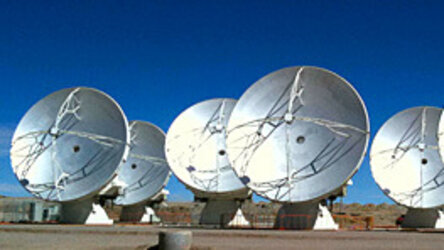Multibeam Active Discrete Lens Antenna
| 564 - Abstract: |
| The European Space Agency offers a multibeam antenna operating between 300 MHz and 300 GHz. The antenna is optimized in number of elements, dimensions, weight, and power amplifiers efficiency. The single aperture antenna represents a replacement for traditional on-board multi reflector dishes. ESA is looking for partners for a licence agreement and for industrializing the technology. |
Description
The offered technology provides an improved architecture for a discrete active lens multibeam antenna with better radiative performance and reduced volume, mass, cost and complexity. The multibeam antenna comprises radiating feed elements and an active radiating structure with a back and a front array, each composed by the same number of radiating elements, a set of connections between the corresponding radiating elements, as well as a set of power amplifiers.
The relative positions of the radiating elements of both arrays and the phase delays introduced by the connections form an active discrete converging lens. The spacing of the radiating elements on the front array is used to realise a "density tapering", i.e. playing on the density of the sampling of the field performed by the radiating elements.
A suitable aperiodic spatial distribution of the radiating elements of the front array allows reducing the grating lobes in the radiation pattern. This allows a reduction of the number of radiation elements, i.e. of cost and weight. A further reduction in mass and weight is obtained by using extremely compact and efficient radiating horns in the front array.
The advantages of such an antenna are:
- Modularity and scalability
- Radio Frequency (RF) power pooling and RF-power-to-beam flexibility
- Graceful degradation, as a failure of a number of the radiating elements will not cause the loss of the full antenna function but will gracefully degrade its performance
Innovations and advantages
An innovative aspect of the offered technology is that the front and back array of the discrete lens are aperiodic. The spacing of the elements varies with their radial position and the variable phase shifters allow beam steering by introducing a linearly-varying phase shift. This allows for compensating for aging, tolerance and deployment errors of the antenna assembly elements.
Another aspect is a method based on synthesis of a reference surface current distribution, preliminary synthesis of the aperiodic front array and iterative refinement of the radiating elements position to obtain the desired radiation performances. This leads to an array which is no longer constituted by elements disposed on concentric rings.
The sandwich support structure is another aspect, which can be realised with high thermal conductivity materials and combines structural support and thermal management functionalities, thus making the active lens system thin and easy to accommodate on-board the satellite.
The small diameter of circular and very compact horns allows arranging the radiating elements close to each other leading to efficient "density tapering". The small length reduces the size and weight of the active lens. The horns are optimized in terms of efficiency and of longitudinal depth. Because of the innovative non-regular layouts used on both side of the lens, and of new high efficiency, really compact horns, the main limitations typical of constrained active lenses have been minimized.
Domains of application
- Data Communications
- Satellite Microwave Communications
- Other related Communications















 Germany
Germany
 Austria
Austria
 Belgium
Belgium
 Denmark
Denmark
 Spain
Spain
 Estonia
Estonia
 Finland
Finland
 France
France
 Greece
Greece
 Hungary
Hungary
 Ireland
Ireland
 Italy
Italy
 Luxembourg
Luxembourg
 Norway
Norway
 The Netherlands
The Netherlands
 Poland
Poland
 Portugal
Portugal
 Czechia
Czechia
 Romania
Romania
 United Kingdom
United Kingdom
 Slovenia
Slovenia
 Sweden
Sweden
 Switzerland
Switzerland




























